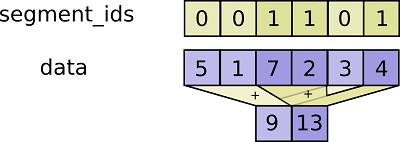TensorFlow 常用函数汇总
本文介绍了tensorflow的常用函数,源自网上整理。
TensorFlow 将图形定义转换成分布式执行的操作, 以充分利用可用的计算资源(如 CPU 或 GPU。一般你不需要显式指定使用 CPU 还是 GPU, TensorFlow 能自动检测。如果检测到 GPU, TensorFlow 会尽可能地利用找到的第一个 GPU 来执行操作.并行计算能让代价大的算法计算加速执行,TensorFlow也在实现上对复杂操作进行了有效的改进。大部分核相关的操作都是设备相关的实现,比如GPU。
下面是一些重要的操作/核:
| 操作组 | 操作 |
| Maths | Add, Sub, Mul, Div, Exp, Log, Greater, Less, Equal |
| Array | Concat, Slice, Split, Constant, Rank, Shape, Shuffle |
| Matrix | MatMul, MatrixInverse, MatrixDeterminant |
| Neuronal Network | SoftMax, Sigmoid, ReLU, Convolution2D, MaxPool |
| Checkpointing | Save, Restore |
| Queues and syncronizations | Enqueue, Dequeue, MutexAcquire, MutexRelease |
| Flow control | Merge, Switch, Enter, Leave, NextIteration |
一、 TensorFlow的算术操作
| 操作 | 描述 |
| tf.add(x, y, name=None) | 求和 |
| tf.sub(x, y, name=None) | 减法 |
| tf.mul(x, y, name=None) | 乘法 |
| tf.div(x, y, name=None) | 除法 |
| tf.mod(x, y, name=None) | 取模 |
| tf.abs(x, name=None) | 求绝对值 |
| tf.neg(x, name=None) |
取负 (y = -x) |
| tf.sign(x, name=None) |
返回符号 y = sign(x) = -1 if x < 0; 0 if x == 0; 1 if x > 0. |
| tf.inv(x, name=None) | 取反 |
| tf.square(x, name=None) | 计算平方 (y = x * x = x^2) |
| tf.round(x, name=None) |
舍入最接近的整数 # ‘a’ is [0.9, 2.5, 2.3, -4.4] |
| tf.sqrt(x, name=None) | 开根号 (y = \sqrt{x} = x^{1/2}). |
| tf.pow(x, y, name=None) |
幂次方 (元素级) # tensor ‘x’ is [[2, 2], [3, 3]] |
| tf.exp(x, name=None) | 计算e的次方 |
| tf.log(x, name=None) | 计算log,一个输入计算e的ln,两输入以第二输入为底 |
| tf.maximum(x, y, name=None) | 返回最大值 (x > y ? x : y) |
| tf.minimum(x, y, name=None) | 返回最小值 (x < y ? x : y) |
| tf.cos(x, name=None) | 三角函数cosine |
| tf.sin(x, name=None) | 三角函数sine |
| tf.tan(x, name=None) | 三角函数tan |
| tf.atan(x, name=None) | 三角函数ctan |
二、张量操作Tensor Transformations
2.1 数据类型转换Casting
| 操作 | 描述 |
| tf.string_to_number (string_tensor, out_type=None, name=None) |
字符串转为数字 |
| tf.to_double(x, name=’ToDouble’) | 转为64位浮点类型–float64 |
| tf.to_float(x, name=’ToFloat’) | 转为32位浮点类型–float32 |
| tf.to_int32(x, name=’ToInt32’) | 转为32位整型–int32 |
| tf.to_int64(x, name=’ToInt64’) | 转为64位整型–int64 |
| tf.cast(x, dtype, name=None) |
将x或者x.values转换为dtype # tensor |
2.2 形状操作Shapes and Shaping
| 操作 | 描述 |
| tf.shape(input, name=None) |
返回数据的shape # ‘t’ is [[[1, 1, 1], [2, 2, 2]], [[3, 3, 3], [4, 4, 4]]] |
| tf.size(input, name=None) |
返回数据的元素数量 # ‘t’ is [[[1, 1, 1], [2, 2, 2]], [[3, 3, 3], [4, 4, 4]]]] |
| tf.rank(input, name=None) |
返回tensor的rank(维度) 注意:此rank不同于矩阵的rank, |
| tf.reshape(tensor, shape, name=None) |
改变tensor的形状 # tensor ‘t’ is [1, 2, 3, 4, 5, 6, 7, 8, 9] |
| tf.expand_dims(input, dim, name=None) |
插入维度1进入一个tensor中 #该操作要求-1-input.dims() |
2.3 切片与合并(Slicing and Joining)
| 操作 | 描述 |
| tf.slice(input_, begin, size, name=None) |
对tensor进行切片操作,从input中抽取部分内容 inputs:可以是list,array,tensor begin:n维列表,begin[i] 表示从inputs中第i维抽取数据时,相对0的起始偏移量,也就是从第i维的begin[i]开始抽取数据 size:n维列表,size[i]表示要抽取的第i维元素的数目 有几个关系式如下: (1) i in [0,n] (2)tf.shape(inputs)[0]=len(begin)=len(size) (3)begin[i]>=0 抽取第i维元素的起始位置要大于等于0 (4)begin[i]+size[i]<=tf.shape(inputs)[i] #’input’ is#[[[1, 1, 1], [2, 2, 2]],[[3, 3, 3], [4, 4, 4]],[[5, 5, 5], [6, 6, 6]]] tf.slice(input, [1, 0, 0], [1, 1, 3]) ==> [[[3, 3, 3]]] tf.slice(input, [1, 0, 0], [1, 2, 3]) ==> [[[3, 3, 3], [4, 4, 4]]] tf.slice(input, [1, 0, 0], [2, 1, 3]) ==> [[[3, 3, 3]], [[5, 5, 5]]] |
| tf.split(split_dim, num_split, value, name=’split’) |
沿着某一维度将tensor分离为num_split tensors # ‘value’ is a tensor with shape [5, 30] |
| tf.concat(concat_dim, values, name=’concat’) |
沿着某一维度连结tensor (整体维度不变) t1 = [[1, 2, 3], [4, 5, 6]] 如果想沿着tensor一新轴连结打包,那么可以: tf.concat(axis, [tf.expand_dims(t, axis) for t in tensors]) |
| tf.pack(values, axis=0, name=’pack’) |
将一系列rank-R的tensor打包为一个rank-(R+1)的tensor (整体维度加一) # ‘x’ is [1, 4], ‘y’ is [2, 5], ‘z’ is [3, 6] |
| tf.reverse(tensor, dims, name=None) |
沿着某维度进行序列反转 # tensor ‘t’ is |
| tf.transpose(a, perm=None, name=’transpose’) |
调换tensor的维度顺序(轴变换) # ‘x’ is [[1 2 3],[4 5 6]] |
| tf.gather(params, indices, validate_indices=None, name=None) |
合并索引 indices 所指示 params 中的切片 |
| tf.one_hot (indices, depth, on_value=None, off_value=None, axis=None, dtype=None, name=None) |
独热编码(ont-hot encoing) indices = [0, 2, -1, 1] |
三、矩阵相关运算
| 操作 | 描述 |
| tf.diag(diagonal, name=None) |
返回一个给定对角值的对角tensor # ‘diagonal’ is [1, 2, 3, 4] |
| tf.diag_part(input, name=None) | 功能与上面相反 |
| tf.trace(x, name=None) | 求一个2维tensor的迹,即对角值diagonal之和 |
| tf.transpose(a, perm=None, name=’transpose’) | 调换tensor的维度顺序(轴变换) |
| tf.matmul(a, b, transpose_a=False, transpose_b=False, a_is_sparse=False, b_is_sparse=False, name=None) |
矩阵相乘(可以处理批数据) |
| tf.matrix_determinant(input, name=None) | 返回方阵的行列式 |
| tf.matrix_inverse(input, adjoint=None, name=None) | 求方阵的逆矩阵,adjoint为True时,计算输入共轭矩阵的逆矩阵 |
| tf.cholesky(input, name=None) | 对输入方阵cholesky分解, 即把一个对称正定的矩阵表示成一个下三角矩阵L和其转置的乘积的分解A=LL^T |
| tf.matrix_solve(matrix, rhs, adjoint=None, name=None) | 求解方程 matrix为方阵shape为[M,M],rhs的shape为[M,K],output为[M,K] |
四、复数操作
| 操作 | 描述 |
| tf.complex(real, imag, name=None) |
将两实数转换为复数形式 # tensor ‘real’ is [2.25, 3.25] |
| tf.complex_abs(x, name=None) |
计算复数的绝对值,即长度 # tensor ‘x’ is [[-2.25 + 4.75j], [-3.25 + 5.75j]] |
| tf.conj(input, name=None) | 计算共轭复数 |
| tf.imag(input, name=None) tf.real(input, name=None) |
提取复数的虚部和实部 |
| tf.fft(input, name=None) | 计算一维的离散傅里叶变换,输入数据类型为complex64 |
五、归约计算(Reduction)
| 操作 | 描述 |
|
tf.reduce_sum(input_tensor, |
计算输入tensor元素的和,或者安照reduction_indices指定的轴进行求和 # ‘x’ is [[1, 1, 1] |
| tf.reduce_prod(input_tensor, reduction_indices=None, keep_dims=False, name=None) |
计算输入tensor元素的乘积,或者按照reduction_indices指定的轴进行求乘积 |
| tf.reduce_min(input_tensor, reduction_indices=None, keep_dims=False, name=None) |
求tensor中最小值 |
| tf.reduce_max(input_tensor, reduction_indices=None, keep_dims=False, name=None) |
求tensor中最大值 |
| tf.reduce_mean(input_tensor, reduction_indices=None, keep_dims=False, name=None) |
求tensor中平均值 |
| tf.reduce_all(input_tensor, reduction_indices=None, keep_dims=False, name=None) |
对tensor中各个元素求逻辑’与’ # ‘x’ is |
| tf.reduce_any(input_tensor, reduction_indices=None, keep_dims=False, name=None) |
对tensor中各个元素求逻辑’或’ |
| tf.accumulate_n(inputs, shape=None, tensor_dtype=None, name=None) |
计算一系列tensor的和 # tensor ‘a’ is [[1, 2], [3, 4]] |
| tf.cumsum(x, axis=0, exclusive=False, reverse=False, name=None) |
求累积和 tf.cumsum([a, b, c]) ==> [a, a + b, a + b + c] |
六、分割(Segmentation)
| 操作 | 描述 |
| tf.segment_sum(data, segment_ids, name=None) |
沿张量的片段计算总和(第一维)
data:一个Tensor。 segment_ids:一个Tensor;必须是以下类型之一:int32,int64; 一维张量,其秩等于data第一维的秩;值应该被排序,并且可以是重复的。 name:操作的名称(可选)。
tf.segment_sum函数返回的是一个Tensor,它与data有相同的类型, 与data具有相同的形状, 但大小为 k(段的数目)的维度0除外。 |
| tf.segment_prod(data, segment_ids, name=None) | 根据segment_ids的分段计算各个片段的积 |
| tf.segment_min(data, segment_ids, name=None) | 根据segment_ids的分段计算各个片段的最小值 |
| tf.segment_max(data, segment_ids, name=None) | 根据segment_ids的分段计算各个片段的最大值 |
| tf.segment_mean(data, segment_ids, name=None) | 根据segment_ids的分段计算各个片段的平均值 |
| tf.unsorted_segment_sum(data, segment_ids, num_segments, name=None) |
与tf.segment_sum函数类似,
|
| tf.sparse_segment_sum(data, indices, segment_ids, name=None) |
输入进行稀疏分割求和 c = tf.constant([[1,2,3,4], [-1,-2,-3,-4], [5,6,7,8]]) |
七、序列比较与索引提取(Sequence Comparison and Indexing)
| 操作 | 描述 |
| tf.argmin(input, dimension, name=None) | 返回input最小值的索引index |
| tf.argmax(input, dimension, name=None) | 返回input最大值的索引index |
| tf.listdiff(x, y, name=None) | 返回x,y中不同值的索引 |
| tf.where(input, name=None) |
返回bool型tensor中为True的位置 # ‘input’ tensor is |
| tf.unique(x, name=None) |
返回一个元组tuple(y,idx),y为x的列表的唯一化数据列表, # tensor ‘x’ is [1, 1, 2, 4, 4, 4, 7, 8, 8] |
| tf.invert_permutation(x, name=None) |
置换x数据与索引的关系 y[x[i]] = i for i in [0, 1, ..., len(x) - 1] # tensor |
八、神经网络(Neural Network)
-
激活函数(Activation Functions)
| 操作 | 描述 |
| tf.nn.relu(features, name=None) | 整流函数:max(features, 0) |
| tf.nn.relu6(features, name=None) | 以6为阈值的整流函数:min(max(features, 0), 6) |
| tf.nn.elu(features, name=None) | elu函数,exp(features) - 1 if < 0,否则features Exponential Linear Units (ELUs) |
| tf.nn.softplus(features, name=None) | 计算softplus:log(exp(features) + 1) |
| tf.nn.dropout(x, keep_prob, noise_shape=None, seed=None, name=None) |
计算dropout,keep_prob为keep概率 noise_shape为噪声的shape |
| tf.nn.bias_add(value, bias, data_format=None, name=None) | 对value加一偏置量 此函数为tf.add的特殊情况,bias仅为一维, 函数通过广播机制进行与value求和, 数据格式可以与value不同,返回为与value相同格式 |
| tf.sigmoid(x, name=None) | y = 1 / (1 + exp(-x)) |
| tf.tanh(x, name=None) | 双曲线切线激活函数 |
-
卷积函数(Convolution)
| 操作 | 描述 |
| tf.nn.conv2d(input, filter, strides, padding, use_cudnn_on_gpu=None, data_format=None, name=None) |
在给定的4D input与 filter下计算2D卷积 输入shape为 [batch, height, width, in_channels] |
| tf.nn.conv3d(input, filter, strides, padding, name=None) | 在给定的5D input与 filter下计算3D卷积 输入shape为[batch, in_depth, in_height, in_width, in_channels] |
-
池化函数(Pooling)
| 操作 | 描述 |
| tf.nn.avg_pool(value, ksize, strides, padding, data_format=’NHWC’, name=None) |
平均方式池化 |
| tf.nn.max_pool(value, ksize, strides, padding, data_format=’NHWC’, name=None) |
最大值方法池化 |
| tf.nn.max_pool_with_argmax(input, ksize, strides, padding, Targmax=None, name=None) |
返回一个二维元组(output,argmax),最大值pooling, 并返回最大值及其相应的索引 |
| tf.nn.avg_pool3d(input, ksize, strides, padding, name=None) |
3D平均值pooling |
| tf.nn.max_pool3d(input, ksize, strides, padding, name=None) |
3D最大值pooling |
-
数据标准化(Normalization)
| 操作 | 描述 |
| tf.nn.l2_normalize(x, dim, epsilon=1e-12, name=None) | 对维度dim进行L2范式标准化 output = x / sqrt(max(sum(x**2), epsilon)) |
| tf.nn.sufficient_statistics(x, axes, shift=None, keep_dims=False, name=None) |
计算与均值和方差有关的完全统计量 返回4维元组,*元素个数,*元素总和,*元素的平方和,*shift结果 参见算法介绍 |
| tf.nn.normalize_moments(counts, mean_ss, variance_ss, shift, name=None) | 基于完全统计量计算均值和方差 |
| tf.nn.moments(x, axes, shift=None, name=None, keep_dims=False) |
直接计算均值与方差 |
-
损失函数(Losses)
| 操作 | 描述 |
| tf.nn.l2_loss(t, name=None) | output = sum(t ** 2) / 2 |
-
分类函数(Classification)
| 操作 | 描述 |
| tf.nn.sigmoid_cross_entropy_with_logits (logits, targets, name=None)* |
计算输入logits, targets的交叉熵 |
| tf.nn.softmax(logits, name=None) | 计算softmax softmax[i, j] = exp(logits[i, j]) / sum_j(exp(logits[i, j])) |
| tf.nn.log_softmax(logits, name=None) | logsoftmax[i, j] = logits[i, j] - log(sum(exp(logits[i]))) |
| tf.nn.softmax_cross_entropy_with_logits (logits, labels, name=None) |
计算logits和labels的softmax交叉熵 logits, labels必须为相同的shape与数据类型 |
| tf.nn.sparse_softmax_cross_entropy_with_logits (logits, labels, name=None) |
计算logits和labels的softmax交叉熵 |
| tf.nn.weighted_cross_entropy_with_logits (logits, targets, pos_weight, name=None) |
与sigmoid_cross_entropy_with_logits()相似, 但给正向样本损失加了权重pos_weight |
-
符号嵌入(Embeddings)
| 操作 | 描述 |
| tf.nn.embedding_lookup (params, ids, partition_strategy=’mod’, name=None, validate_indices=True) |
根据索引ids查询embedding列表params中的tensor值 1、如果partition_strategy为”mod”, 2、如果partition_strategy为”div”,那么分配方案为: |
| tf.nn.embedding_lookup_sparse(params, sp_ids, sp_weights, partition_strategy=’mod’, name=None, combiner=’mean’) |
对给定的ids和权重查询embedding 1、sp_ids为一个N x M的稀疏tensor, 2、sp_weights的shape与sp_ids的稀疏tensor权重, |
-
循环神经网络(Recurrent Neural Networks)
| 操作 | 描述 |
| tf.nn.rnn(cell, inputs, initial_state=None, dtype=None, sequence_length=None, scope=None) |
基于RNNCell类的实例cell建立循环神经网络 |
| tf.nn.dynamic_rnn(cell, inputs, sequence_length=None, initial_state=None, dtype=None, parallel_iterations=None, swap_memory=False, time_major=False, scope=None) |
基于RNNCell类的实例cell建立动态循环神经网络 与一般rnn不同的是,该函数会根据输入动态展开 返回(outputs,state) |
| tf.nn.state_saving_rnn(cell, inputs, state_saver, state_name, sequence_length=None, scope=None) |
可储存调试状态的RNN网络 |
| tf.nn.bidirectional_rnn(cell_fw, cell_bw, inputs, initial_state_fw=None, initial_state_bw=None, dtype=None, sequence_length=None, scope=None) |
双向RNN, 返回一个3元组tuple (outputs, output_state_fw, output_state_bw) |
-
求值网络(Evaluation)
| 操作 | 描述 |
|---|---|
| tf.nn.top_k(input, k=1, sorted=True, name=None) | 返回前k大的值及其对应的索引 |
| tf.nn.in_top_k(predictions, targets, k, name=None) | 返回判断是否targets索引的predictions相应的值 是否在在predictions前k个位置中, 返回数据类型为bool类型,len与predictions同 |
对于有巨大量的多分类与多标签模型,如果使用全连接softmax将会占用大量的时间与空间资源,所以采用候选采样方法仅使用一小部分类别与标签作为监督以加速训练。
| 操作 | 描述 |
| Sampled Loss Functions | |
| tf.nn.nce_loss(weights, biases, inputs, labels, num_sampled, num_classes, num_true=1, sampled_values=None, remove_accidental_hits=False, partition_strategy=’mod’, name=’nce_loss’) |
返回noise-contrastive的训练损失结果 |
| tf.nn.sampled_softmax_loss(weights, biases, inputs, labels, num_sampled, num_classes, num_true=1, sampled_values=None, remove_accidental_hits=True, partition_strategy=’mod’, name=’sampled_softmax_loss’) |
返回sampled softmax的训练损失 参考- Jean et al., 2014第3部分 |
| Candidate Samplers | |
| tf.nn.uniform_candidate_sampler(true_classes, num_true, num_sampled, unique, range_max, seed=None, name=None) |
通过均匀分布的采样集合 返回三元tuple 1、sampled_candidates 候选集合。 2、期望的true_classes个数,为浮点值 3、期望的sampled_candidates个数,为浮点值 |
| tf.nn.log_uniform_candidate_sampler(true_classes, num_true, num_sampled, unique, range_max, seed=None, name=None) |
通过log均匀分布的采样集合,返回三元tuple |
| tf.nn.learned_unigram_candidate_sampler (true_classes, num_true, num_sampled, unique, range_max, seed=None, name=None) |
根据在训练过程中学习到的分布状况进行采样 返回三元tuple |
| tf.nn.fixed_unigram_candidate_sampler(true_classes, num_true, num_sampled, unique, range_max, vocab_file=”, distortion=1.0, num_reserved_ids=0, num_shards=1, shard=0, unigrams=(), seed=None, name=None) |
基于所提供的基本分布进行采样 |
九、保存与恢复变量
| 操作 | 描述 |
| 类tf.train.Saver(Saving and Restoring Variables) | |
| tf.train.Saver.__init__(var_list=None, reshape=False, sharded=False, max_to_keep=5, keep_checkpoint_every_n_hours=10000.0, name=None, restore_sequentially=False, saver_def=None, builder=None) |
创建一个存储器Saver var_list定义需要存储和恢复的变量 |
| tf.train.Saver.save(sess, save_path, global_step=None, latest_filename=None, meta_graph_suffix=’meta’, write_meta_graph=True) |
保存变量 |
| tf.train.Saver.restore(sess, save_path) | 恢复变量 |
| tf.train.Saver.last_checkpoints | 列出最近未删除的checkpoint 文件名 |
| tf.train.Saver.set_last_checkpoints(last_checkpoints) | 设置checkpoint文件名列表 |
| tf.train.Saver.set_last_checkpoints_with_time(last_checkpoints_with_time) | 设置checkpoint文件名列表和时间戳 |
出处:http://www.guoyaohua.com
微信:guoyaohua167
邮箱:guo.yaohua@foxmail.com
本文版权归作者和博客园所有,欢迎转载,转载请标明出处。
【如果你觉得本文还不错,对你的学习带来了些许帮助,请帮忙点击右下角的推荐】







